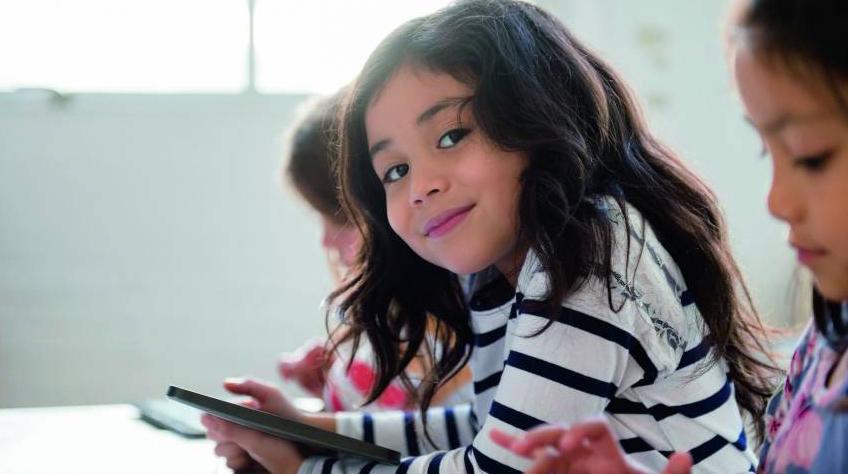News
Creativity – and a passion for a new ways of learning
10-05-2019

How knowledge is transmitted and how we learn have both undergone a qualitative leap forward. Enhanced digital environments mean that teaching can be increasingly flexible, agile and personalized. Gone is old-school passive learning by rote, centered on the teacher who dictated lessons from the front of the classroom.
"Since the beginning of the decade, we’ve been working on digital innovation, in terms of both our product portfolio as well as the organizational structures of the company, with specific resources allocated for technology and innovation," explains Miguel Barrero, global director of R&D+iat Santillana. "We initially set up a Digital Development division that, over time, grew into a Learning Technology Department, on the one hand, and another R&D+idivision that addresses the school as a whole, where pedagogical and technological innovations are intertwined".
For Santillana, digital transformation has entailed a thorough organizational metamorphosis in just a few years. "We’ve gone from being a print content company to an edtech company offering content, services and technology", adds Miguel Barrero. Because, as he points out, Santillana is convinced that "innovation in schools will arise as a resultmixing things and through a hybrid use of media. Wherever paper is more effective, there is no reason to change that; but wherever digital is more appropriate, it will have to be incorporated"
The Compartir project, designed by Santillana in 2012, is a clear example of this symbiosis, according to Miguel Barrero. "It combines content in print and in digital versions (with aproprietary e-textbook format), an LMS (Learning Management System) platform to manage access to content and enable academic management, digital services for evaluation and assessment, training services and consulting, a community aimed atbringing together all the educational players, and hardware for the classroom.”
The learning platform operates at Basic and Secondary level education, and is aimed at students aged between 6 and 16. "We are already in 15 Latin American countries, in 2,120 schools where we serve almost 770,000 students," says Miguel Barrero. Digital learning takes a gradual and modular approach: each school decides those areas where it can be best deployed. It works across a wide range of devices (Android tablets, Chromebooks and laptops), blackboard, interactive projectors, “maker” classrooms with 3D printers and mobile classrooms. And Santillana is with the school every step of the way: whether it’s helping with content, technology or services. Compartir uses a subscription model that gives the user access to all the components that make up the system, a high proportion of which are products developed by Santillana itself, such as the virtual learning environment services (the e-stela platform) and the platform for the evaluation and preparation of online exams, called Pleno. There are also agreements with third parties, such as the MyOn English reading platform. And implementation in schools is turnkey.
"All content is developed in each country where Santillana has a presence and follows the official curriculumset by each national Ministry of Education. Regulatory compliance in terms of content and the adaptation to education systems of each territory are thus guaranteed,” says Miguel Barrero.
Santillana’s other major innovative education initiative is called UNOi, a disruptive project created in 2011, and implemented in almost 900 schools in Brazil, Colombia and Mexico, with a reach of more than 273,000 students.
"This is a more far-reaching model from a pedagogical point of view and more immersive in terms of the use of technologies. It addresses the school, all subjects and levels, as a whole, meaning that the adoption of UNOi affects a school across the board," explains Santillana's head of R&D+i. "As a digitizationproject, it is much more ambitious than Compartir. For example, with UNOi you can scan the labor market with the 21st Century Skills program, and then there are programming and code workshops, learning by projects and a module for “maker learning”, which might include the installation of a “maker” classroom in the school.”
UNOi combines both print and digital pedagogy, environments and content in three languages: Spanish, Portuguese and English, with Cambridge certification available for English. Like Compartir, the Santillana Group has a network of coaches available in each country where it operates, offering teacher training, and supporting the management teams and liaising with families. Because, according to Miguel Barrero, "as the system becomes more sophisticated and the process of transformation of the school gets underway in earnest, being there and liaising is key to success".
Big data and enhanced learning
"What we’re busy doing right now," explains Miguel Barrero, "is using data in order to obtain analytics that will allow us to personalize learning and make better decisions". Digitization, he says, has revolutionized learning. "Animation or video can help understanding a concept enormously compared to resources that merely employ text and illustration." And technology has also had a huge impact on the assessment and evaluation of knowledge: "This is one area where technologies have proved enormously productive: especially when it comes to making tests, giving them in the classroom (automatic, in real time), and for correction (this no longer needs to be manual) and the exploitation of the data ".
It may interest you



